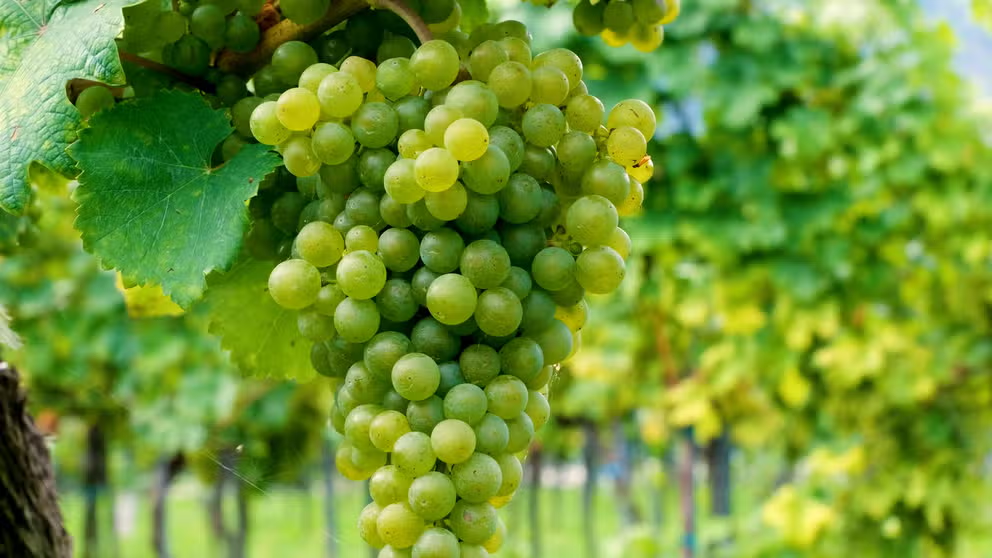Weather’s guide to wine country: Where to find your favorite wines thanks to the weather
Bold reds, grassy whites, fruity Zins and crisp sparkling wines – you will find them all in different places because of the weather.
How weather impacts your glass of wine
From rain to humidity to hurricanes, a variety of factors can impact the taste and availability of wine.
A meteorologist can be a great guide in wine country. Weather and climate not only dictate which grapes can grow where, but they also impact the wine’s taste and character. So, the same grape will taste differently depending on the weather.
"Weather is the number one factor in grape growing and success," said winemaker Matilda Scott of Almacerro in Napa Valley. "The latitude and the weather patterns that you would traditionally find within those regions are what have allowed for grapevines to prosper and to be able to produce the wine that we make."
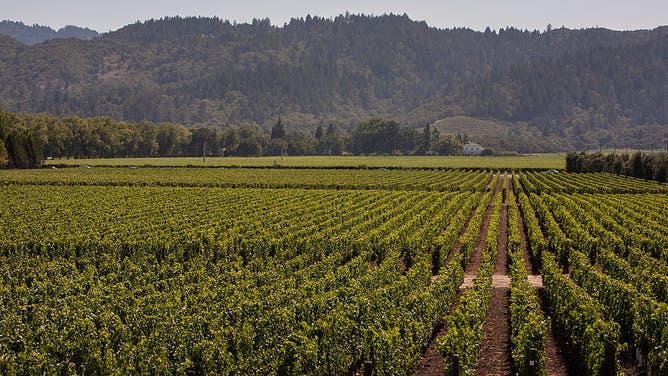
One of the Opus One vineyards which encompass 170 in Napa Valley.
(George Rose/Getty Images / Getty Images)
Traditional wine regions are in the same narrow bands in both hemispheres
Too close to the equator, it can be too warm, she said. Too far from it, it's too cool and the grapes won’t ripen.
"If it's too warm, you don't get the seasonal change and the vines won’t go into dormancy, so they won't produce the quality of the crop that makes good wine," Scott said. "And then if it gets too cold, then the season is not long enough for vines to be able to grow, and they aren't able to mature the grapes for the wine harvest."
While grape vines can grow in almost every latitude, premier wines are generally produced between 30 and 50 degrees latitude. That holds true for the Southern Hemisphere, too. The right amount of water, sunlight and warmth is the recipe for a good wine.
NAPA VALLEY 2020: THE LOST VINTAGE TO WILDFIRE SMOKE
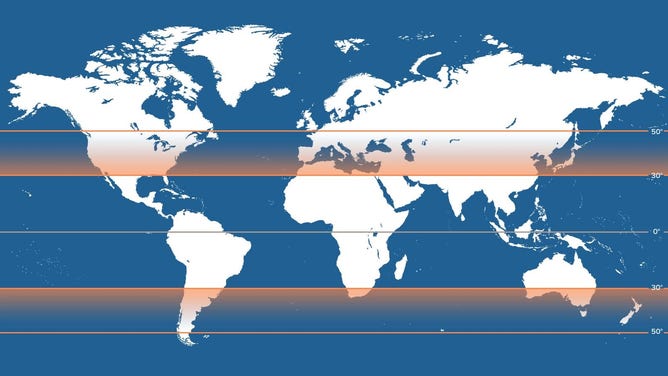
Geography can have an enormous impact on the way that your wine tastes. Temperature, altitude, types of soil - the place where the grapes are grown and how they are able to ripen, determines so much about the character of the final product. Traditional wine growing areas are in orange between 30 and 50 degrees latitude.
(Wine and Spirit Education Trust / FOX Weather)
American Viticultural Areas (AVAs) generally differentiate microclimates
Fine-tuning weather variables within latitudes takes us to microclimates. Napa Valley, California, is home to many different varieties because of its unique weather. Some regions have an official name. For example, take a look at the AVA, or American Viticultural Area, named on some bottles and differentiate the geographic and climatic features.
"So in Carneros, they traditionally grow Pinot Noir and Chardonnay because they do better in cooler weather," Scott said. "You can ripen Pinot Noir and Chardonnay at a cooler mean (average of high and low) temperature than you can Cabernet. Cabernet would not traditionally ripen if it's not warm enough for long enough."
You may have noticed the taste of under-ripe grapes, for example. Think of a wine that has a hint similar to green bell pepper. That is OK for white wines but generally not considered desirable in reds. That naturally occurring compound responsible for the aroma is reduced by ripening, writes ETS Labs, which chemically analyzes grapes and wines for vintners.
DISCOVERY COULD PREVENT GRAPES TAINTED BY WILDFIRE SMOKE FROM RUINING WINE
Loving the cool
The Carneros region, or AVA, sits in south Napa Valley, just above the San Pablo Bay. Almost every afternoon in late spring and summer, the Sun heats up inland areas. The warm air rises and cooler, denser air from the Pacific comes charging in across the San Francisco Bay into San Pablo Bay and is funneled through Napa Valley between mountain ranges.
That breeze is not only cool, it is also moist. San Francisco is infamous for its chilly summers because of this effect. Meteorologists call it the marine layer, the low clouds and sometimes fog that arrives on the afternoon breeze. The clouds travel up-valley and only erode the next morning or midday.
HOW WEATHER CAN IMPACT WINE PRODUCTION
Why is San Francisco so foggy?
Meteorologist Ian Oliver explains the marine layer and why several have said, "the coldest winter I ever spent was a summer in San Francisco."
"That keeps it cool in the afternoon, whereas up-valley you stay warm, so it's ripening your Petite Syrah, your Zinfandel and your Cabernet up-valley," Scott said. "Down-valley, even if the Sun comes out, the moderating influence of the water keeps it overall cool, so the vines don't ripen too quickly or get too ripe."
Elevation can also take vines out of the shallow marine layer. Scott’s vineyards are on Howell Mountain (also an AVA) at almost 1,800 feet. She said the wineries there often use the tagline "above the fogline." Morning sun warms grapes up faster in the day.
Some like it hot
Howell Mountain is just east of St. Helena on the map, about halfway up the valley from the San Pablo Bay. So, the vineyard still gets some cooling afternoon breezes. She said the property is usually 5 to 10 degrees cooler than St. Helena, which is on the valley floor. She said that sometimes Carneros can be 20 degrees cooler than up-valley areas like Calistoga.
WEATHER HAS NAPA WINEMAKERS WALKING FINE LINE BETWEEN SPECTACULAR VINTAGE AND ROT WITH LATE HARVEST

File: A winemaker set up netting to provide cooling shade for established Cabernet vines in Calistoga in August 2019. Calistoga is one of the warmer regions being well up-valley.
(iz Hafalia/The San Francisco Chronicle / Getty Images)
"But our diurnal change, the temperature difference between night and day, is somewhat smaller, which allows us to ripen grapes," said Scott. "Otherwise, they might not be able to get ripe. So on the mountains, you're looking for more acidity and stronger tannins, like Howell Mountain is known for."
Those are the big, bold Cabs that California is internationally known for. Naturally occurring tannins mellow with age, so you don’t necessarily want to drink those wines too young, she said. More sun and higher temperatures mean more photosynthesis, which sweetens the grapes' sugar production. Eventually, the sugar is converted to alcohol. Cool nights preserve the "fresh acidity."
Valley floor wines start out mellower and have fresh fruit characteristics because they are "under the fogline" and in the fog, she said.
WHAT DOES ALL THIS RAIN IN CALIFORNIA MEAN FOR THE WINE?
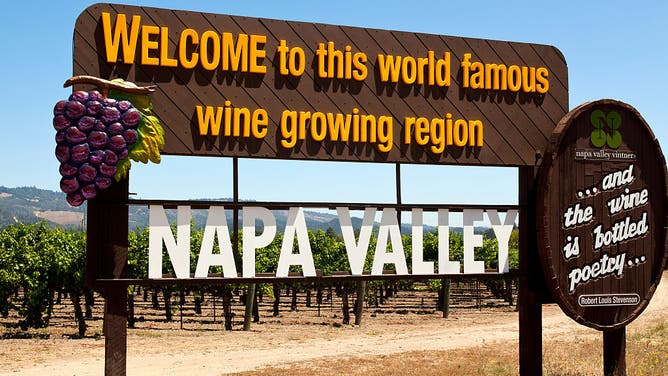
File: The iconic Napa Valley sign, in front of a vineyard.
(ANDREW HOLBROOKE/Corbis / Getty Images)
"It's overall cooler than the valley floor. So the phenolic development (chemicals giving pigments and flavor) is protected," Scott said. "If you get too much sun, those tannins synthesize in the grapes, which is why on the valley floor you get really beautiful, lush fruit like the red fruit spectrum, the blue fruit spectrum – so full body with smoother tannins."
Tannins help give a wine structure. But wine that could use more aging may taste a little bitter or astringent and leave your tongue feeling dry. Bitter tannins, mainly found in the seeds, skin and stems, protect young grapes from being eaten by pests and parasites before the fruit is ripe, according to Wine Enthusiast.
Sonoma wine country, where you will find the Pinots and Chards, is closer to the coast and cooler with less of a diurnal range. Santa Barbara also gets the cool afternoon winds off the Pacific, which crawl through canyons and passes. Oregon and Washington are known for Pinot Noirs, Chardonnay, Syrah and Rieslings because of the cooler climate.
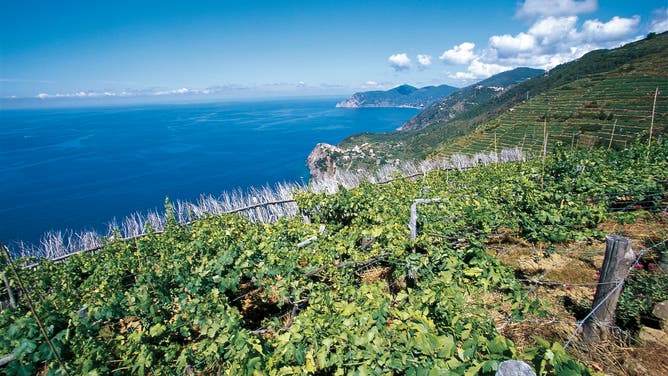
File: Just like in the U.S., grapes in these vineyards near Manarola, Cinque Terre National Park, Liguria, Italy are white varietals that like the cooler sea air.
(DEA / S. AMANTINI / Getty Images)
Grapes like Chardonnay actually bloom earlier in the spring than reds. While they prosper in cooler temperatures, late spring frosts can damage the new shoots and buds. Valley-floor fruit is very vulnerable because the dense, cool air drains down mountains and pools in the valleys.
Thinner-skinned Pinot Noir grapes have fewer tannins than their thick-skinned Cab cousins. White wines are not kept on the skins and seeds long enough for the tannins to seep into the liquid.
Sparkling wines love cooler climes
Look for sparkling wine grapes in cooler climates as well.
"So the thing with sparkling wine is you want it to be higher acidity and less sugar ripeness than other varietals," said Scott. "If you're making wine for sparkling, you don't want to grow it where it's hot because things ripen too quickly, and you don't get that nice acidity and low alcohol as well."
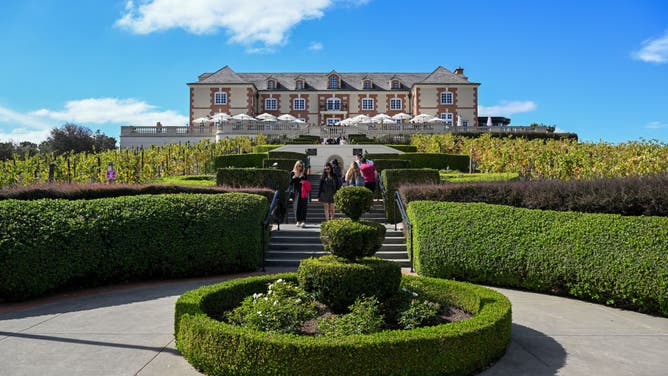
File: Domaine Carneros in Napa's Carneros region is known for sparkling wines.
(Tayfun Coskun/Anadolu / Getty Images)
Vintners can arrange rows so the fruit gets more or less sun: Place the more finicky varietals in shadier spots to tweak the growing cycle.
Too hot is not good either. Cool nights are important because they allow the grapes to preserve their fresh acidity, she said. And photosynthesis is slowed or stopped at 90 degrees, according to research.
Good wine takes struggle on the vine's part
And premier wines need struggle. That’s why we generally don’t see high price tags for inland wines, like in the Central Valley of California. The plentiful sun and irrigation in the Breadbasket of America makes for abundant and tasty produce, like table grapes, that feeds a quarter of the nation, according to the U.S. Geological Survey, but not for fine wine.
"Vines like to struggle because that concentrates everything," explained Scott. "And if they're in poor mountain soils and they're fighting for every bit of water, every bit of nutrient, they’re concentrating on making good berries rather than lots of berries."
